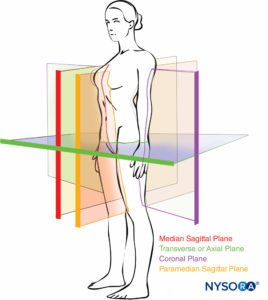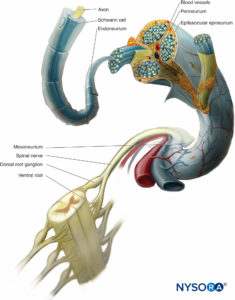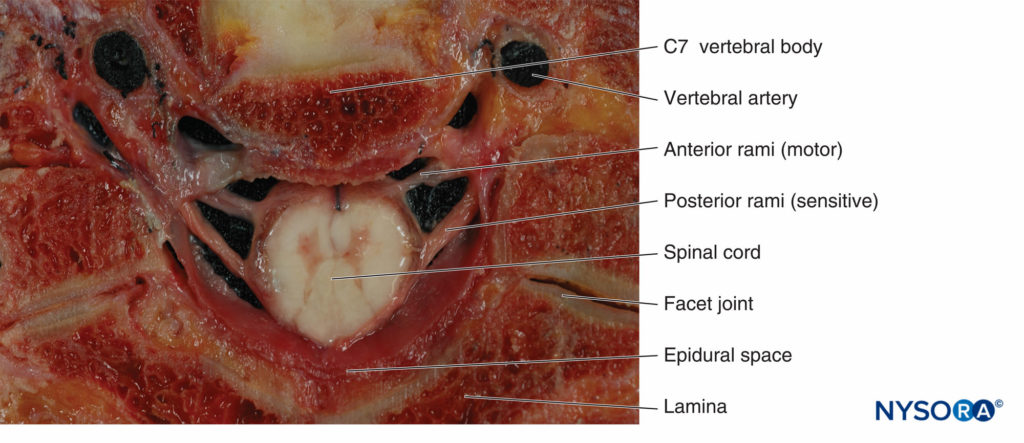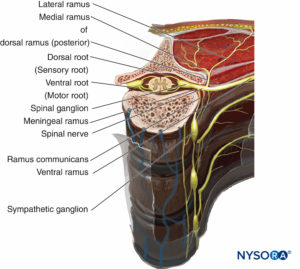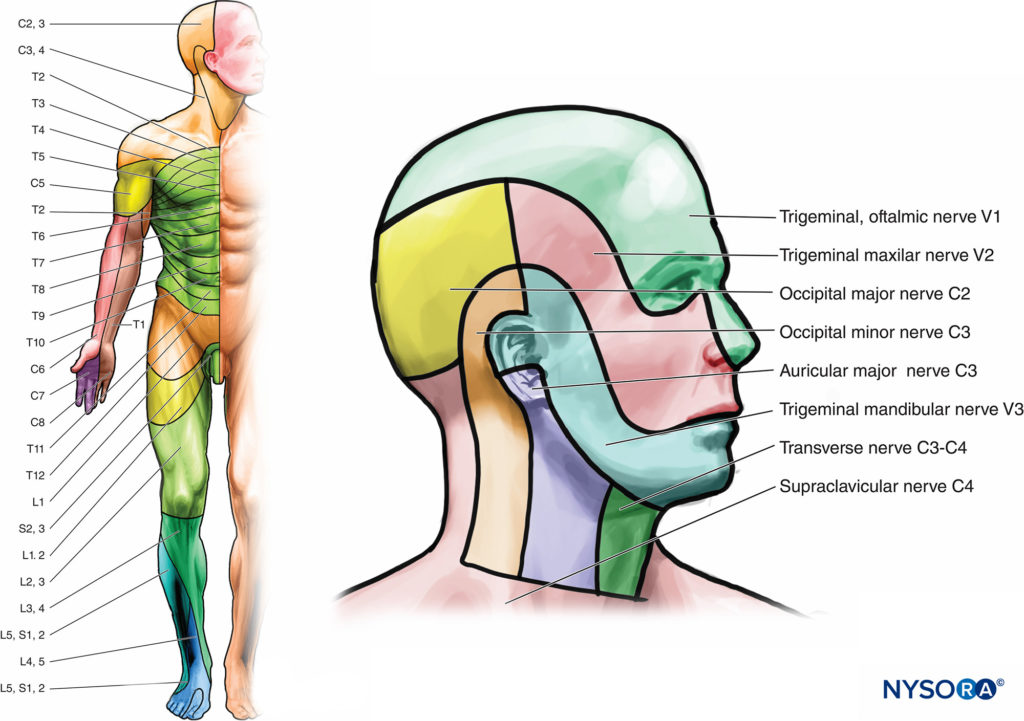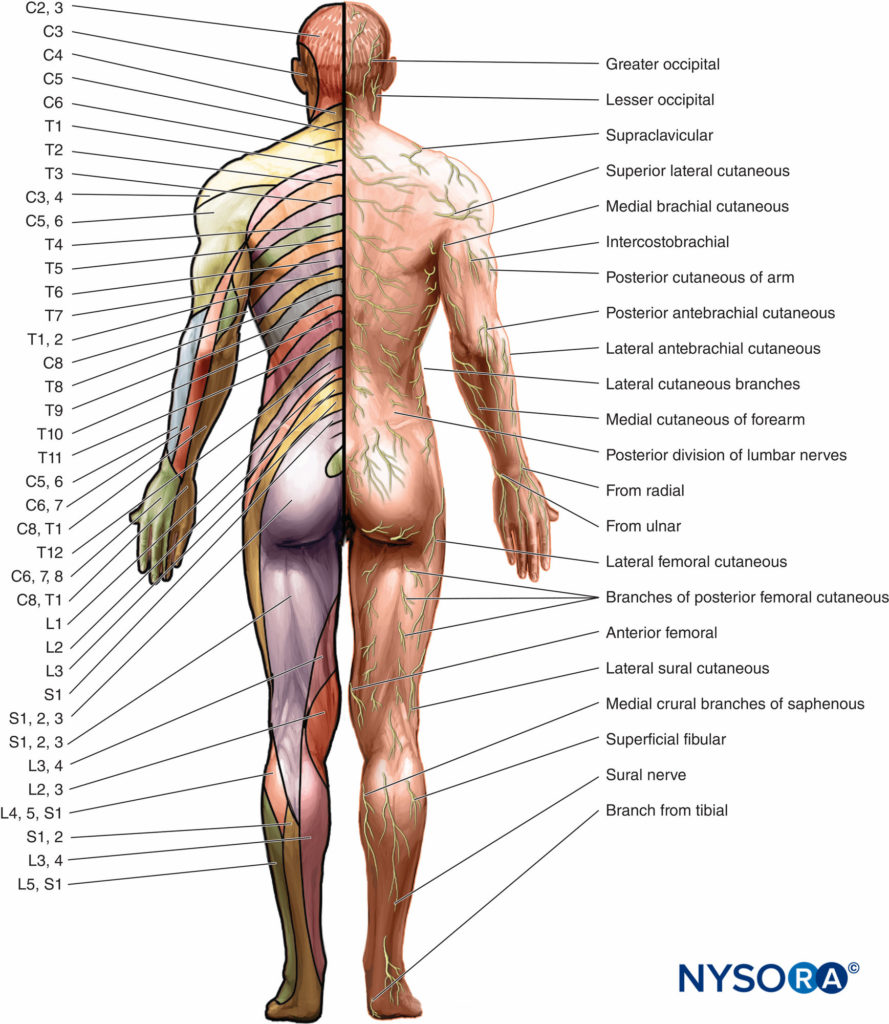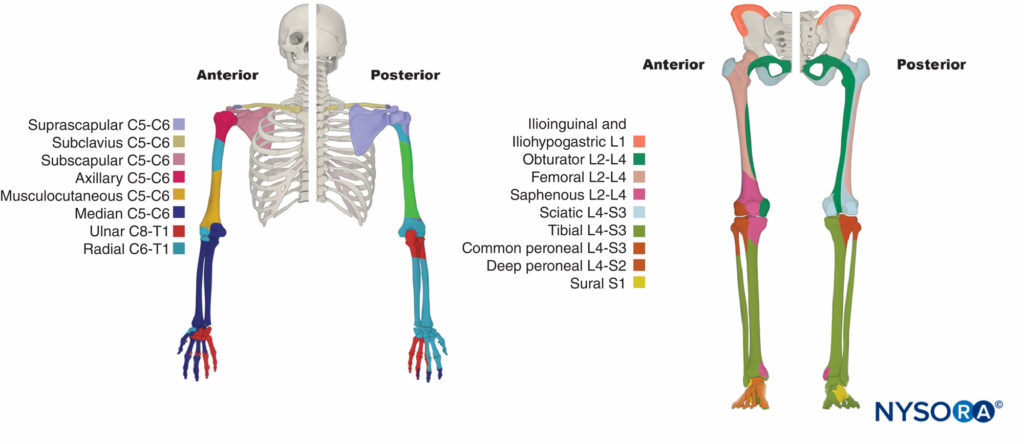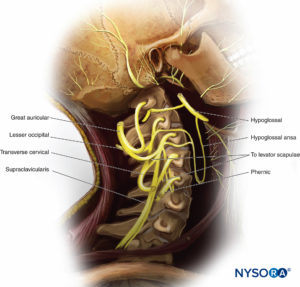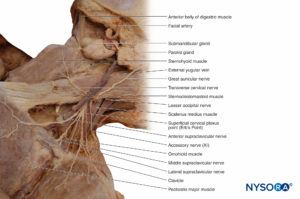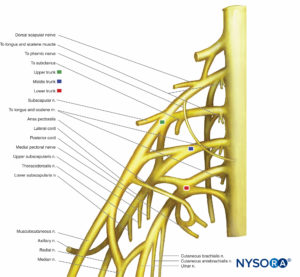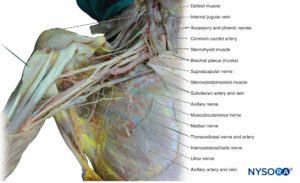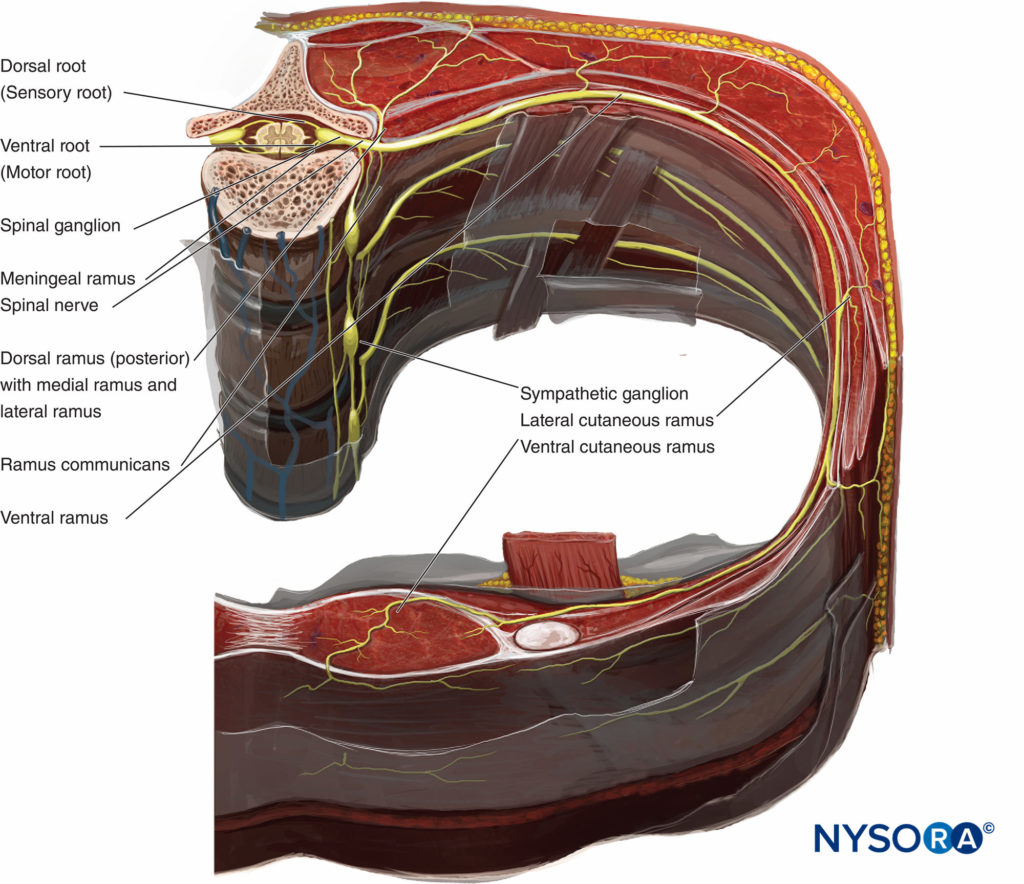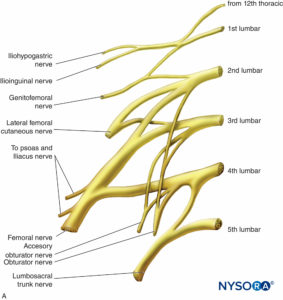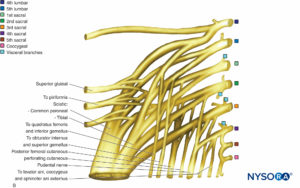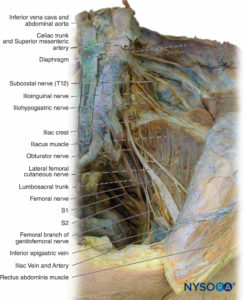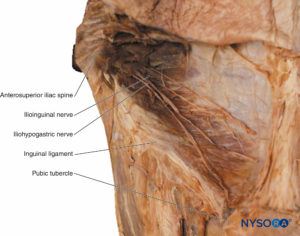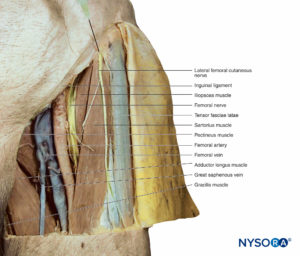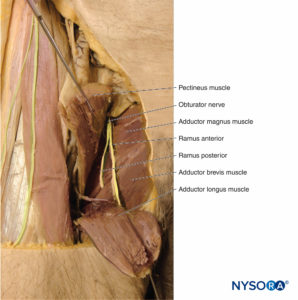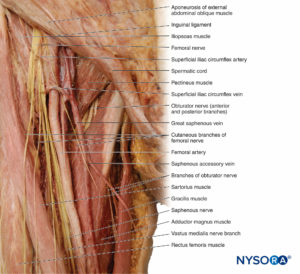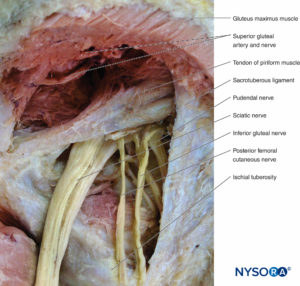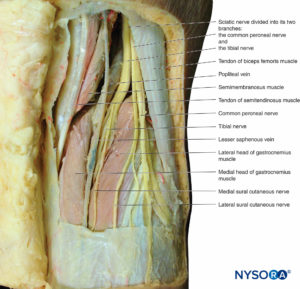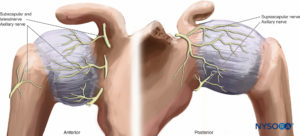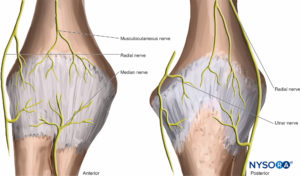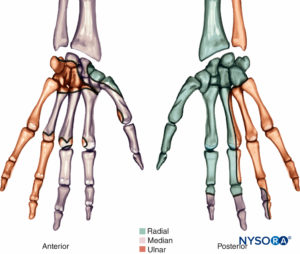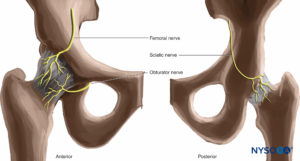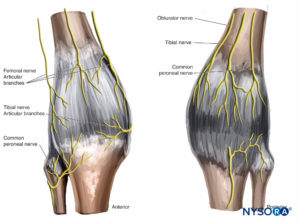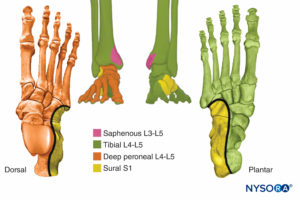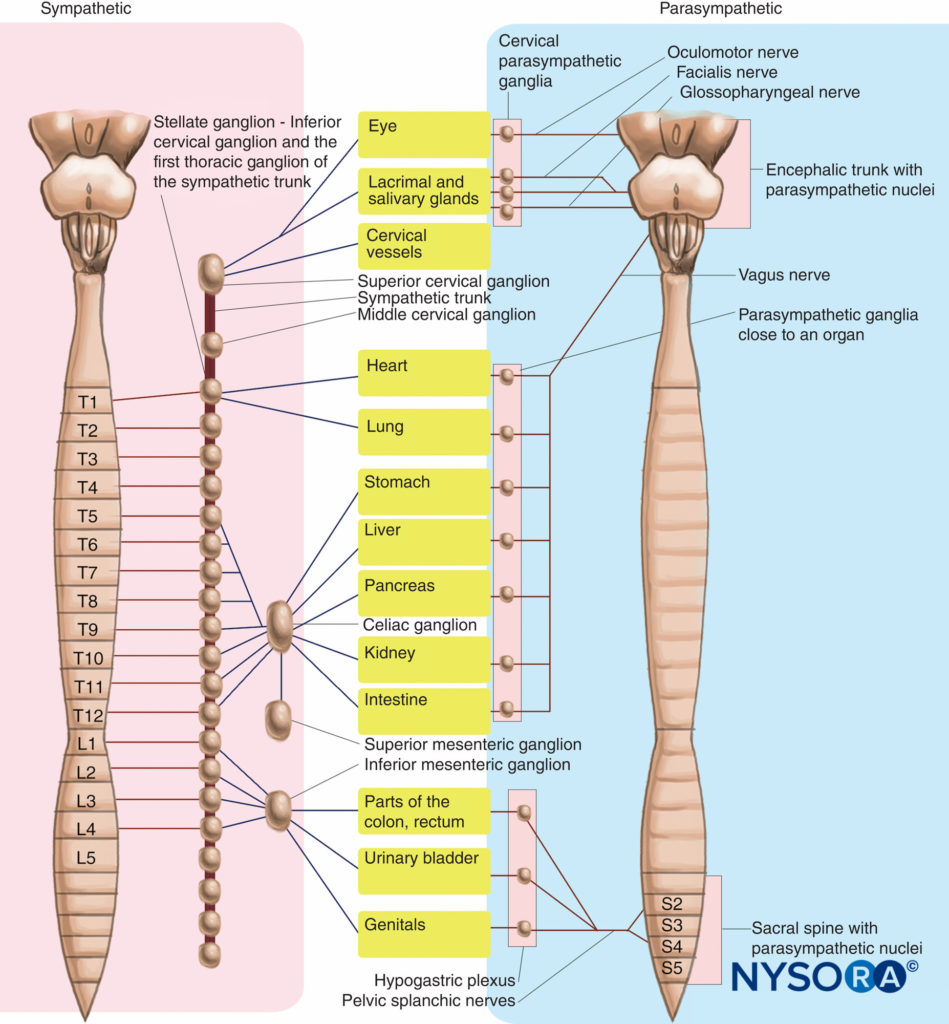Anna Carrera, Ana M. Lopez, Xavier Sala-Blanch, Eldan Kapur, Ilvana Hasanbegovic, and Admir Hadzic
INTRODUCTION
The practice of regional anesthesia is inconceivable without sound knowledge of the functional regional anesthesia anatomy. Just as surgical technique relies on surgical anatomy or pathology leans on pathologic anatomy, the anatomic information necessary for the practice of regional anesthesia must be specific to this application. In the past, many nerve block techniques and approaches were devised by academicians merely relying on idealized anatomic diagrams and schematics, rather than on functional anatomy. However, once the anatomic layers and tissue sheets are dissected, the anatomy of nerve structures without the tissue sheaths around them is of little relevance to the clinical practice of regional anesthesia. This is because accurate placement of the needle and the spread of the local anesthetic after an injection depend on the interplay between neurologic structures and the neighboring tissues where local anesthetic pools and accumulates, rather than on the mere anatomic organization of the nerves and plexuses. Much research on functional regional anesthesia, a term introduced by Dr. Jerry Vloka in the 1990s, has contributed to better understanding of the anatomy of regional nerve block. Moreover, the introduction of ultrasound in the practice of regional anesthesia has further clarified the relationship of the needle and the nerve and the dynamics of local anesthetic spread.
The goal of this chapter is to provide a generalized and rather concise overview of anatomy relevant to the practice of regional anesthesia; more specific anatomic discussions pertaining to individual regional anesthesia techniques are detailed in their respective chapters. The reader is referred to Figure 1 for an easier orientation of the body planes discussed throughout the book.
ANATOMY OF PERIPHERAL NERVES
All peripheral nerves are similar in structure. The neuron is the basic functional neuronal unit responsible for the conduction of nerve impulses. Neurons are the longest cells in the body, many reaching a meter in length. Most neurons are incapable of dividing under normal circumstances and have limited ability to repair themselves after injury. A typical neuron consists of a cell body (soma) that contains a large nucleus. The cell body is attached to several branching processes, called dendrites, and a single axon. Dendrites receive incoming messages; axons conduct outgoing messages. Axons vary in length, and there is one only per neuron. In peripheral nerves, axons are long and slender. They are also called nerve fibers. The peripheral nerve is composed of three parts: (1) somatosensory or afferent neurons, (2) motor or efferent neurons, and (3) autonomic neurons.
Individual nerve fibers bind together, somewhat like individual wires in an electric cable (Figure 2). In the peripheral nerve, individual axons are eveloped by the endoneurium, which is a delicate layer of loose connective tissue around each axon. Groups of axons are closely associated within a bundle called a nerve fascicle that is surrounded by the perineurium, which imparts mechanical strength to the peripheral nerve. In surgical procedures, the perineurium holds sutures without tearing. In addition to its mechanical strength, the perineurium functions as a diffusion barrier to the fascicle, isolating the endoneural space around the axon from the surrounding tissue. This barrier helps to preserve the ionic milieu of the axon and functions as a blood–nerve barrier. The perineurium surrounds each fasciculus and splits with it at each branching point. The fascicular bundles in turn are embedded in loose connective tissue called the interfascicular epineurium, which contains adipose tissue, fibroblasts, mastocytes, blood vessels (with small nerve fibers innervating these vessels), and lymphatics. In contrast, a more dense collagenous tissue forms the epineurium that surrounds the entire nerve and holds it loosely to the connective tissue through which it travels.
Of note, the fascicular bundles are not continuous throughout the peripheral nerve. They divide and anastomose with one another as frequently as every few millimeters. However, the axons within a small set of adjacent bundles redistribute themselves so that the axons remain in approximately the same quadrant of the nerve for several centimeters. This arrangement is a practical concern to the surgeons trying to repair a severed nerve. If the cut is clean, it may be possible to suture individual fascicular bundles together. In such a scenario, there is a greater chance that the distal segment of nerves synapsing with the muscles will be sutured to the central stump of motor or sensory axons. In such cases, good functional recovery is more likely. If a short segment of the nerve is missing, however, the fascicles in the various quadrants of the stump may no longer correspond with one another, good axial alignment may not be possible, and functional recovery is greatly compromised or improbable. This arrangement of the peripheral nerve helps explain why intraneural injections may result in disastrous consequences.
The connective tissue of a nerve is tougher, compared to the nerve fibers themselves, and allows a certain amount of “stretch” without damage to the nerve fibers. For instance, the axons are somewhat “wavy,” and when stretched, the connective tissue around them is also stretched giving it some protection. This feature plays a “safety” role in nerve block by allowing the nerves to be “pushed” rather than pierced by the advancing needle, as often seen on ultrasound. For this reason, it is prudent to avoid stretching the nerves and nerve plexuses during nerve block (eg, in axillary brachial plexus blocks and some approaches to the sciatic block).
The paraneurium consists of loose connective tissue that holds a stable relationship between adjacent structures filling the space in between them, such as the neurovascular bundles of intermuscular septae. This tissue contributes to functional mobility of nerves during joint and muscular movement.
Nerves receive blood from the adjacent blood vessels running along their course. These feeding branches to larger nerves are macroscopic in size and irregularly arranged, forming anastomoses to become longitudinally running vessel(s) that supply the nerve and give off subsidiary branches. Although the connective tissue sheath enveloping nerves serves to protect the nerves from stretching, it is also believed that neuronal injury after nerve block may be due, at least partly, to the pressure or stretch within connective sheaths that do not stretch well and the consequent interference with the vascular supply to the nerve.
Communication Between the Central and Peripheral Nervous Systems
The functional boundary between the central nervous system (CNS) and the peripheral nervous system (PNS) lies at the junction where oligodendrocytes meet Schwann cells along the axons that form the cranial and spinal nerve. The CNS communicates with the body through spinal nerves. Spinal nerves have both sensory and motor components (Figure 3). The sensory fibers arise from neurons in the dorsal root ganglia. Fibers enter the dorsolateral aspect of the spinal cord to form the dorsal root. The motor fibers arise from neurons in the ventral horn of the spinal cord. The fibers pass through the ventrolateral aspect of the spinal cord and form the ventral root. The dorsal and ventral roots converge in the intervertebral foramen to form a spinal nerve. After passing through the intervertebral foramen, the spinal nerve divides into dorsal and ventral rami. The dorsal ramus innervates muscle, bones, joints, and the skin of the back. The ventral ramus innervates muscle, bones, joints, and the skin of the anterior neck, thorax, abdomen, pelvis, and the extremities.
Spinal Nerves
There are 31 pairs of spinal nerves (Figure 4). The spinal nerves are enumerated by region: 8 cervical, 12 thoracic, 5 lumbar, 5 sacral, and 1 coccygeal. Spinal nerves pass through the vertebral column at the intervertebral foramina. The first cervical nerve (C1) passes superior to the C1 vertebra (atlas). The second cervical nerve (C2) passes between the C1 (atlas) and C2 (axis) vertebrae. This pattern continues down the cervical spine. A shift in pattern occurs at the C8 nerve because there is no C8 vertebra. The C8 nerve passes between the C7 and T1 vertebrae. The T1 nerve passes between the T1 and T2 vertebrae. This pattern continues down the remainder of the spine. The vertebral arch of the fifth sacral and first coccygeal vertebrae is rudimentary. Because of this, the vertebral canal opens inferiorly at the sacral hiatus. The fifth sacral and first coccygeal nerves pass through the sacral hiatus. Because the inferior end of the spinal cord (conus medullaris) in adults is located at the L1 to L2 vertebral level, roots of spinal nerves must descend through the vertebral canal before exiting the vertebral column through the appropriate intervertebral foramen. Collectively, these roots are called the cauda equina.
Outside the vertebral column, ventral rami from different spinal levels coalesce to form intricate networks called plexuses. From the plexuses, nerves extend into the neck, the arms, and the legs.
DERMATOMES, MYOTOMES, AND OSTEOTOMES
Dermatomal, myotomal, and osteotomal innervations are often emphasized in regional anesthesiology texts as important for the application of nerve blocks. In clinical practice of regional anesthesia, however, it is more practical to think in terms of which block techniques provide adequate analgesia and anesthesia for specific surgical procedures, rather than attempt to match nerves and spinal segments to the relevant dermatomal, myotomal, and osteotomal territory. Nevertheless, the description of dermatomal, myotomal, and osteotomal innervation is of didactic importance in regional anesthesia and is briefly presented here.
A dermatome is an area of the skin supplied by the dorsal (sensory) root of the spinal nerve (Figures 5a, 5b, and 6). In the trunk, each segment is horizontally disposed, except C1, which does not have a sensory component. The dermatomes of the limbs from the fifth cervical to the first thoracic nerve and from the third lumbar to the second sacral vertebrae extend as a series of bands from the midline of the trunk posteriorly into the limbs. It should be noted that considerable overlapping occurs between adjacent dermatomes; that is, each segmental nerve overlaps the territories of its neighbors.
A myotome is the segmental innervation of skeletal muscle by the ventral (motor) root(s) of the spinal nerve(s). Major myotomes, their function, and corresponding spinal levels are represented in Figure 7. The innervation of the bones and joints (osteotome) often does not follow the same segmental pattern as the innervation of the muscles and other soft tissues (Figure 8).
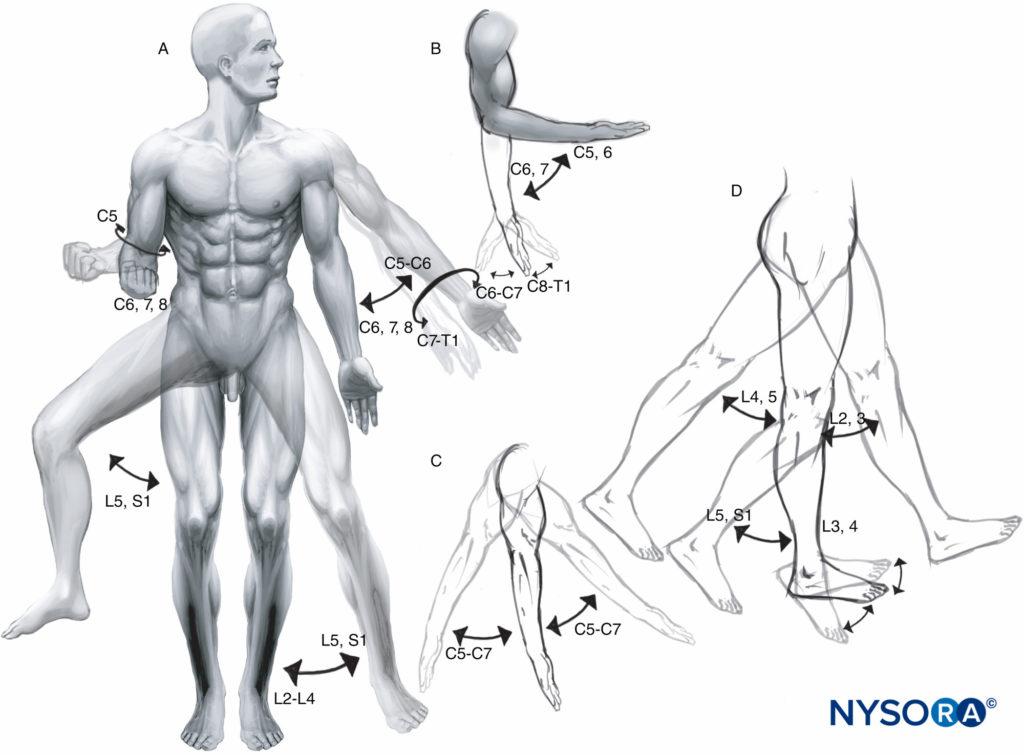
FIGURE 7. Functional innervation of the muscles (myotomes): A: Medial and lateral rotation of shoulder and hip, pronation and supination of wrist and forearm. Abduction and adduction of shoulder and hip. B: Flexion and extension of elbow and wrist. C: Flexion and extension of shoulder. D: Flexion and extension of hip, and knee. Dorsiflexion and plantar flexion of ankle, lateral views.
ANATOMY OF PLEXUSES AND PERIPHERAL NERVES
Cervical Plexus
The cervical plexus innervates muscles, joints, and skin in the anterior neck (Table 1). It is formed by the ventral rami of C1 through C4 (Figures 9 and 10). The rami form a loop called the ansa cervicalis that sends branches to the infrahyoid muscles. In addition, the rami, form nerves that pass directly to several structures in the neck and thorax, including the scalene muscles, diaphragm, clavicular joints, and skin covering the anterior neck.
TABLE 1. Organization and distribution of the cervical plexus.
| Nerves | Spinal Segments | Distribution |
|---|---|---|
| Ansa cervicalis (superior and inferior branches) | C1 to C4 | Five of the extrinsic laryngeal muscles (sternothyroid, sternohyoid, omohyoid, geniohyoid, and thyrohyoid) by way of CN XII |
| Lesser occipital, transverse cervical, supraclavicular, and greater auricular nerves | C2 to C3 | Skin of upper chest, shoulder, neck, and ear |
| Phrenic nerve | C3 to C5 | Diaphragm |
| Cervical nerves | C1 to C5 | Levator scapulae, scalenes, sternocleidomastoid, and trapezius muscles (with CN XI) |
Ansa Cervicalis
The ventral ramus of C1 attaches to the ventral rami of C2 to C3. The attachment forms a loop called the ansa cervicalis, which sends branches to the infrahyoid muscles. The infrahyoid muscles consist of the omohyoid, sternohyoid, and sternothyroid muscles. They attach to the anterior surface of the hyoid bone or to the thyroid cartilage. Contraction of these muscles moves the hyoid bone or thyroid cartilage downward, effectively opening the laryngeal aditus, promoting inspiration. The C1 component also sends fibers to the thyrohyoid and geniohyoid muscles. Contraction of these muscles moves the anterior hyoid bone superiorly, closing the laryngeal aditus. Closure of the laryngeal aditus is necessary for swallowing to occur safely. This is one of the reasons why high levels of spinal anesthesia result in airway compromise and the risk of aspiration.
Nerves to Scalene Muscles
The ventral rami of C2 to C4 send branches directly to the scalene muscles, which attach between the cervical spine and ribs. When the cervical spine is stabilized, contraction elevates the ribs. This promotes inspiration. An interscalene block may result in a block of the scalene muscles in addition to the phrenic block.
This is typically asymptomatic in healthy patients but may result in acute respiratory insufficiency in patients with borderline pulmonary function or in those with an exacerbation of asthma or chronic obstructive bronchitis. It is recommended that more distal approaches to a brachial plexus block and smaller injection volumes be used to limit the cephalad extension of the block, as well as shorter-acting local anesthetics to avoid prolonged block in case of respiratory insufficiency.
Phrenic Nerve
The phrenic nerve is formed by junction of fibers from C3 to C5, (Figure 10) and it innervates the diaphragm. The phrenic nerve descends through the neck on the anterior surface of the anterior scalene muscle, passing through the superior thoracic aperture and descending on the walls of the mediastinum to the diaphragm. In addition to muscular fibers, the phrenic nerve transmits sensory fibers to the superior and inferior surfaces of the diaphragm. All approaches to the block of the brachial plexus above the clavicle with high volumes result in phrenic block (Figure 12).
Cutaneous Nerves of the Anterior Neck
Cutaneous sensory nerves arise from the cervical plexus, pass around the posterior margin of sternocleidomastoid, and terminate in the scalp and anterior neck. The minor occipital nerve passes to the posterior auricular region of the scalp. The major auricular nerve passes to the auricle of the ear and to the region of the face anterior to the tragus. The transverse cervical nerve supplies the anterior neck. A series of supraclavicular nerves innervate the region covering the clavicle. Furthermore, the supraclavicular nerves may provide articular branches to the sternoclavicular and acromioclavicular joints.
Brachial Plexus
The brachial plexus innervates bones, joints, muscles, and the skin of the upper extremity (Table 2). It is formed by ventral rami of C5 to T1 (Figures 11 and 12). In the posterior cervical triangle between the anterior and middle scalene muscles, the ventral rami join to form trunks. C5 and C6 join to form the superior trunk. C7 forms the middle trunk. C8 and T1 join to form the inferior trunk. All trunks branch into anterior and posterior divisions. All the posterior divisions join to form the posterior cord. The anterior divisions of the superior and middle trunks join to form the lateral cord. The anterior division of the inferior trunk forms the medial cord. Several terminal nerves arise within the posterior cervical triangle. Because they arise superior to the clavicle, they are called supraclavicular branches. The supraclavicular branches include the dorsal scapular nerve, the long thoracic nerve, the suprascapular nerve, and the nerve to the subclavius.
TABLE 2. Organization and distribution of the brachial plexus.
| Nerves | Spinal Segments | Distribution |
|---|---|---|
| Nerves to subclavius | C4 to C6 | Subclavius muscle |
| Dorsal scapular nerve | C5 | Rhomboid muscles and levator scapulae muscle |
| Long thoracic nerve | C5 to C7 | Serratus anterior muscle |
| Suprascapular nerve | C5, C6 | Supraspinatus and infraspinatus muscles |
| Pectoralis nerve (median and lateral) | C5 to T1 | Pectoralis muscles |
| Subscapular nerves | C5, C6 | Subscapularis and teres major muscles |
| Thoracodorsal nerve | C6 to C8 | Latissimus dorsi muscle |
| Axillary nerve | C5, C6 | Deltoid and teres minor muscles; skin of shoulder |
| Radial nerve | C5 to T1 | Extensor muscle of the arm and forearm (triceps brachii, extensor carpi radialis, supinator and anconeus muscles, and extensor carpi ulnaris muscles) and brachioradialis muscle; digital extensors and abductor pollicis muscle; skin over the posterolateral surface of the arm |
| Musculocutaneous nerve | C5 to C7 | Flexor muscles on the arm (biceps brachii, brachialis, and coracobrachialis muscles); skin over lateral surface of forearm |
| Median nerve | C6 to T1 | Flexor muscles on the forearm (flexor carpi radialis and palmaris longus muscles); pronator quadratus and pronator teres muscles; digital flexors (through the palmar interosseous nerve); skin over anterolateral surface of hand |
| Ulnar nerve | C8, T1 | Flexor carpi ulnaris muscle, adductor pollicis muscle, and small digital muscles; medial part of flexor digitorum profundus muscle; skin over medial surface of the hand |
Supraclavicular Branches Dorsal Scapular Nerve
The dorsal scapular nerve arises from the ventral ramus of C5. It follows the levator scapula muscle to the scapula and descends the medial border of the scapula on the deep surface of the rhomboid muscles. In its route, the dorsal scapular nerve innervates the levator scapula and rhomboid muscles.
Long Thoracic Nerve
The long thoracic nerve arises from the ventral rami of C5 to C7. It descends along the anterior surface of the middle scalene to the first rib and then transfers onto the serratus anterior muscle, which it innervates.
Suprascapular Nerve
The suprascapular nerve arises from the superior trunk. It follows the inferior belly of the omohyoid muscle to the scapula; passes through the superior notch into the supraspinatus fossa, where it innervates the supraspinatus muscle; and continues around the scapular notch (lateral margin of the scapular spine) to the infraspinatus fossa, where it innervates the infraspinatus muscle. In addition to muscle, the suprascapular nerve innervates the posterior aspect of the glenohumeral joint, subacromial bursa, and acromioclavicular joint.
Nerve to Subclavius
The nerve to subclavius arises from the superior trunk. It passes anteriorly a short distance to innervate the subclavius muscle and the sternoclavicular joint.
The cords of the brachial plexus leave the posterior cervical triangle and enter the axilla through the axillary inlet. The remainder of the terminal branches arise within the axilla from the cords (Figure 12).
Posterior Cord Branches
The posterior cord forms the upper and lower subscapular nerves, thoracodorsal nerve, axillary nerve, and radial nerve.
Subscapular Nerves
The subscapular nerves are formed by fibers from C5 to C6. The upper subscapular nerve is the first nerve to arise from the posterior cord. It passes onto the anterior surface of the subscapularis muscle, which it innervates. The lower subscapular nerve arises more distally. It descends across the anterior surface of the subscapularis muscle to the teres major muscle and innervates both the subscapularis and teres major muscles.
Thoracodorsal Nerve
The thoracodorsal nerve is formed by fibers from C5 to C7. It arises from the posterior cord, usually between the subscapular nerves, and descends across the subscapularis and teres major muscle to the latissimus dorsi muscle. It innervates the latissimus dorsi.
Axillary Nerve
The axillary nerve is formed by fibers from C5 to C6 (Box 1). It passes from the axilla into the shoulder between the teres major and minor muscles, the long head of triceps and humerus quadrangular space of Velpeau. It innervates the teres minor. The nerve continues posteriorly to the surgical neck of the humerus to innervate the deltoid muscle. The superior lateral brachial cutaneous branch of the axillary nerve passes around the posterior margin of the deltoid to innervate the skin covering the deltoid. In addition to muscle and skin, the axillary nerve innervates the glenohumeral and acromioclavicular joints. Throughout its course, the nerve is associated with the posterior circumflex humeral artery and its branches.
BOX 1. Axillary nerve (C5 to C6).
Muscular branches
- Abduction, flexion, or extension of the shoulder
- Deltoid
- Lateral rotation the shoulder; stabilization of glenohumeral joint
- Teres minor
Articular branches
- Acromioclavicular joint
- Anterior aspect of glenohumeral joint
Cutaneous branch
- Superior lateral brachial cutaneous nerve
Radial Nerve
The radial nerve is formed by fibers from C5 to T1 (Box 2). It passes from the axilla into the arm through the triangular space. The triangular space is located inferior to the teres major between the long head of the triceps brachii and the humerus. The radial nerve innervates the long head of the triceps muscle and sends a posterior brachial cutaneous branch to the skin covering this muscle. It descends along the shaft of the humerus in the spiral groove in association with the deep radial artery. In the spiral groove, the radial nerve innervates the medial and lateral heads of the triceps brachii as well as the anconeus muscles. In addition to innervating these muscles, it sends an inferior lateral brachial cutaneous nerve to the skin covering the posterior arm and a posterior antebrachial cutaneous branch to the skin covering the posterior surface of the forearm. The radial nerve pierces the lateral intermuscular septum and crosses the elbow anterior to the lateral epicondyle between the brachialis and brachioradialis muscles. Here, it divides into a superficial and deep branch. The superficial branch descends the forearm on the deep surface of the brachioradialis. Proximal to the wrist, it enters the skin, providing innervation over the dorsum of the hand onto the thumb, index, middle, and ring fingers to the level of the distal interphalangeal joint. The deep branch pierces the supinator muscle and descends the forearm along the interosseous membrane as the posterior interosseous nerve. En route, it innervates the brachioradialis, extensor carpi radialis longus and brevis, supinator, extensor digitorum communis, extensor digiti minimi, extensor carpi ulnaris, extensor indicis, extensor pollicis longus and brevis, and abductor pollicis muscles. In addition, it innervates the humerus, elbow, radioulnar, and wrist joints.
BOX 2. Radial nerve.
Muscular branches
- Extension of shoulder
- Triceps brachii—long head
- Extension of elbow
- Triceps brachii—long, lateral, medial heads
- Anconeus
- Supination of forearm
- Supinator
- Extension of wrist
- Extensor carpi radialis—longus and brevis
- Extensor carpi ulnaris
- Extensor muscles of fingers and thumb listed next
- Extension of fingers (metacarpophalangeal and interphalangeal joints)
- Extensor digitorum communis (index, middle, ring, little fingers)
- Extensor indicis (index finger)
- Extensor digiti minimi (little finger)
- Extension of thumb
- Extensor pollicis longus (metacarpophlangeal and interphalangeal)
- Extensor pollicis brevis (metacarpophalangeal joint)
- Abduction of thumb
- Abductor pollicis longus
Articular branches
- Elbow (humeroradial and humeroulnar joints)
- Radioulnar joints—proximal and distal
- Radiocarpal joint
Cutaneous branches
- Posterior brachial cutaneous nerve
- Inferior lateral brachial cutaneous nerve
- Posterior antebrachial cutaneous nerve
- Superficial branch of the radial nerve
Branches From the Lateral Cord
The lateral cord forms the lateral pectoral nerve, musculocutaneous nerve, and part of the median nerve.
Lateral Pectoral Nerve
The lateral pectoral nerve is formed by fibers from C5 to C7. It crosses the axilla deep to the pectoralis minor muscle and penetrates the deep surface of pectoralis major muscle, which it innervates. In addition, it innervates the acromioclavicular joint.
Musculocutaneous Nerve
The musculocutaneous nerve is formed by fibers from C5 to C7 (Box 3). It pierces the coracobrachialis muscle and descends between the brachialis and biceps brachii muscles (see Figure 12). En route, it innervates all of these muscles. At the elbow, the musculocutaneous nerve becomes the lateral antebrachial cutaneous nerve and descends along the superficial surface of the brachioradialis muscle, innervating the skin covering that muscle. In addition to muscle and skin, the musculocutaneous nerve innervates the humerus elbow and proximal radioulnar joints.
BOX 3. Musculocutaneous nerve (C5 to C7).
Muscular branches
- Flexion of the shoulder
- Biceps brachii—long head
- Coracobrachialis
- Flexion of elbow
- Brachialis (humeroulnar joint)
- Biceps brachii—long and short heads (humeroradial joint)
- Supination of forearm
- Biceps brachii—long and short heads
Articular branches
- Elbow (humeroulnar and humeroradial joints)
- Proximal radioulnar joint
Cutaneous branch
- Lateral antebrachial cutaneous nerve
Median Nerve
The median nerve is formed by the junction of branches from the lateral and medial cords (Box 4). It descends the arm in association with the brachial artery and crosses the cubital fossa medial to the artery (see Figure 12). At the elbow, it innervates the pronator teres, flexor carpi radialis, and palmaris longus muscles. It passes into the forearm between the humeral and radial heads of the pronator teres muscle and descends in the space between the flexor digitorum superficialis and profundus muscles. En route, it innervates the flexor digitorum superficialis, the lateral part of the flexor digitorum profundus (fibers to the index and middle fingers), the flexor pollicis longus, and the pronator quadratus muscles. In addition, the median nerve sends a palmar cutaneous branch to the skin covering the thenar eminence. At the wrist, the median nerve passes through the carpal tunnel deep to the flexor retinaculum. In the hand, the median nerve sends branches to the thenar muscles, which are the abductor pollicis brevis, flexor pollicis brevis, and opponens pollicis. The median nerve divides into three common palmar digital branches, which innerve the lateral two lumbrical muscles. The common palmar branches divide into proper palmar branches that innervate the skin of the thumb, index, middle, and ring (lateral half) fingers. The innervation covers the palmar surface and the nail beds. In addition to muscle and skin, the median nerve innervates the diaphysis of the radius and ulna, and the anterior elbow and all joints distal to it.
BOX 4. Median nerve.
Muscular branches
- Flexion of the elbow
- Flexor carpi radialis
- Pronator teres
- Pronation of forearm
- Pronator teres
- Pronator quadratus
- Flexion of wrist
- Flexor carpi radialis
- Palmaris longus
- Flexor digitorum superficialis and profundus
- Flexor pollicis longus
- Flexion of fingers
- Flexor digitorum superficialis (index, middle, ring, little fingers)
- Flexor digitorum profundus (index, middle fingers)
- Flexion of metacarpophalangeal and extension of interphalangeal joints
- Lumbricals (index, middle finger)
- Flexion of thumb
- Flexor pollicis longus
- Flexor pollicis brevis
- Abduction of thumb
- Abductor pollicis brevis
- Opposition of thumb
- Opponens pollicis
Articular branches
- Elbow (humeroulnar and humeroradial joints)
- Radioulnar joints—proximal and distal
- All joints of the wrist and hand
Cutaneous branches
- Palmar branch of median nerve
- Proper palmar digital nerves
Medial Cord Branches
The medial cord forms the medial pectoral nerve, medial brachial cutaneous nerve, medial antebrachial cutaneous nerve, and ulnar nerve and sends fibers to the median nerve.
Medial Pectoral Nerve
The medial pectoral is formed by fibers from C8 to T1. It pierces the pectoralis minor and ends by branching on the deep surface of the pectoralis major, innervating both muscles. Contraction of the pectoralis minor in conjunction with the serratus anterior and rhomboid muscles pulls the pectoral girdle (clavicle and scapula) against the chest wall when load is applied to the upper extremity. Without this stabilization of the proximal joints, movement of the distal joint in the upper extremity would collapse.
Medial Brachial and Antebrachial Cutaneous Nerves
Both medial brachial and antebrachial cutaneous nerves descend in the arm associated with the brachial artery. The medial brachial cutaneous nerve distributes fibers to the skin covering the medial surface of the arm. Occasionally, the medial brachial nerve joins the lateral cutaneous branch of the second intercostal nerve to form the intercostobrachial nerve. The medial antebrachial cutaneous nerve crosses the cubital fossa and enters the skin to innervate the medial aspect of the forearm.
Ulnar Nerve
The ulnar nerve is formed by fibers from C8 to T1 (Box 5). It descends the arm in association with the brachial artery (see Figures 11 and 12), pierces the medial intermuscular septum, and crosses the elbow posterior to the medial epicondyle. After crossing the elbow, the ulnar nerve descends the forearm between the flexor carpi ulnaris and flexor digitorum profundus, innervating both muscles. The ulnar innervation of the flexor digitorum is limited to fibers affecting the ring and little fingers. Proximal to the wrist, the ulnar nerve sends a palmar branch to the skin covering the hypothenar eminence and a dorsal branch to the skin covering the dorsal and medial surface of the hand and the skin covering the dorsal surface of the ring and little fingers. The ulnar nerve passes through Guyon’s canal (deep to the transverse carpal ligament) to enter the hand. It divides into a superficial and a deep branch. The superficial branch sends branches to all muscles of the hypothenar eminence, including the abductor digiti minimi, flexor digiti minimi, and opponens digiti minimi. Then, it divides into common palmar digital branches, which in turn divide into proper palmar digital branches. These branches innervate the skin covering the palmar surface of the ring and little fingers. The innervation continues on to the nail beds of these fingers. The deep branch of the ulnar nerve passes beneath the adductor pollicis muscle, which it innervates. The ulnar nerve sends fibers to all interosseous muscles in the hand and to the lumbrical muscles affecting the ring and little fingers. The ulnar nerve ends by innervating the deep head of the flexor pollicis brevis muscle.
Along with its course, the ulnar nerve supplies the medial aspect of the elbow joint, the ulna and all joints of the medial aspect of the wrist, hand, and ring and little fingers.
BOX 5. Ulnar nerve (C8 to T1).
Muscular branches
- Flexion of wrist
- Flexor carpi ulnaris
- Flexor digitorum profundus
- Flexion of fingers
- Flexor digitorum profundus (ring, little finger)
- Flexor digiti minimi (little finger)
- Flexion of knuckles and extension of fingers
- Lumbricals (ring, little finger)
- Interosseous muscles (index, middle, ring, little fingers)
- Adduction of fingers (metacarpophalangeal joint)
- Palmar interosseous muscles (index, middle, ring, little finger)
- Abduction of fingers
- Dorsal interosseous muscles (index, middle, ring finger)
- Abductor digiti minimi (little finger)
- Opposition of little finger
- Opponens digiti minimi
- Palmaris brevis
- Adduction of thumb
- Adductor pollicis
- Flexion of thumb
- Flexor pollicis brevis
Articular branches
- Ulnocarpal joint
- All joints of the hand except interphalangeal joint of the thumb
Cutaneous branches
- Dorsal branch of the ulnar nerve
- Palmar branch of the ulnar nerve
- Proper palmar digital branches
Thoracic Spinal Nerves
Thoracic spinal nerves innervate the muscles, joints, skin, and pleuroperitoneal lining of the thoracic and abdominal walls. Because the nerves travel within the intercostal spaces, they are called intercostal nerves. The intercostal nerves comprise the anterior rami of the upper 11 thoracic spinal nerves. Each intercostal nerve enters the neurovascular plane posteriorly and gives a collateral branch that supplies the intercostal muscles of the space. Except for the first, each intercostal nerve gives off a lateral cutaneous branch that pierces the overlying muscle near the midaxillary line. This cutaneous nerve divides into anterior and posterior branches, which supply the adjacent skin (Figure 13).The intercostal nerves of the second to the sixth spaces enter the superficial fascia near the lateral border of the sternum and divide into medial and lateral cutaneous branches. Most of the fibers of the anterior ramus of the first thoracic spinal nerve join the brachial plexus for distribution to the upper limb. The small first intercostal nerve is the collateral branch and supplies only the muscles of the intercostal space, not the overlying skin.
The intercostal nerves can be divided into two groups. One group is formed by nerves arising from T1 through T5. These nerves remain in the intercostal spaces throughout their course. The second group is formed by nerves arising from T6 to T12. These nerves initially travel in the intercostal spaces, but then cross the costal margin and terminate in the abdominal wall. This subgroup of intercostal nerves is called the thoracoabdominal nerves. The ventral ramus of T12 forms the subcostal nerve. This nerve travels entirely in the abdominal wall.
Intercostal Nerves
The intercostal nerves arise from the ventral rami of T1 through T11. They travel along the inferior margin of the rib of the corresponding number (eg, T1 nerve travels along the inferior margin of rib 1). En route, the nerve is located between the deepest (transverse thoracis muscle) and intermediate layer (internal intercostals muscle) of muscle. It is associated with the intercostal arteries and veins. From the top to the bottom, the neurovascular bundle is arranged as vein, artery, and nerve (mnemonic VAN). The intercostal nerves send branches to the transverse thoracis, internal intercostals, and external intercostal muscles. They innervate the costal joints. Through lateral and anterior cutaneous branches, they innervate the skin covering the respective intercostal spaces as well as the parietal pleura lining the intercostal spaces.
Thoracoabdominal (Intercostals T6 to T11) Nerves
The T6 through T11 intercostal (thoracoabdominal) nerves begin as typical intercostal nerves but then send branches across the costal margin into the muscles of the anterior abdominal wall. These branches innervate the transverse abdominis, internal abdominal oblique, external abdominal oblique, and rectus abdominis muscles. In addition, they innervate the skin of the anterior wall in a metameric manner from the xiphoid process to the umbilicus.
Subcostal Nerve
The T12, or subcostal, nerve never enters an intercostal space. It travels through the abdominal wall, terminating between the umbilicus and the pubic symphysis. It innervates muscle and skin along its course.
Lumbosacral Plexus
The lumbosacral plexus innervates the muscles, joints, skin, and peritoneal lining of the abdominopelvic wall (Tables 3 and 4). It also innervates the inferior extremities. It is formed by the ventral rami of L1 to S5 (Figures 14 and 15). The ventral rami join to form the terminal nerves. Between the L2 and S3 levels, the plexus is more complex. The ventral rami divide into anterior and posterior divisions that join to form the terminal nerves. The plexus is located in the posterior abdominal wall between the psoas major and quadratus lumborum muscles (see Figure 15).
Iliohypogastric Nerve
The iliohypogastric nerve arises from the ventral ramus of L1 and travels in the abdominal wall to the level of the pubic symphysis (see Figures 15 and 16). It innervates the muscle, skin, and parietal peritoneum along its course.
Ilioinguinal Nerve
The ilioinguinal nerve (see Figures 15 and 16) arises from the ventral rami of L1, travels in the abdominal wall, pierces in the posterior wall of the inguinal canal, passes through the superficial inguinal ring, and terminates on the anterior scrotum or labia majora. It innervates the muscle, skin, and parietal peritoneum along its course.
TABLE 3. Organization and distribution of the lumbar plexus
| Nerves | Spinal Segments | Distribution |
|---|---|---|
| Iliohypogastric nerve | T12 to L1 | Abdominal muscles (external and internal oblique muscles, transverse abdominis muscles); skin over inferior abdomen and buttocks |
| Ilioinguinal nerve | L1 | Abdominal muscles (with iliohypogastric nerve); skin over superior, medial thigh and portions of external genitalia |
| Genitofemoral nerve | L1, L2 | Skin over anteromedial surface of thigh and portions over genitalia |
| Lateral femoral cutaneous nerve | L2, L3 | Skin over anterior, lateral, and posterior surfaces of thigh |
| Femoral nerve | L2 to L4 | Anterior muscles of thigh (sartorius muscle and quadriceps group); adductor of thigh (pectineus and iliopsoas muscles); skin over anteromedial surface of thigh, medial surface of leg, and foot |
| Obturator nerve | L2 to L4 | Adductors of thigh (adductors magnus, brevis, and longus); gracilis muscle; skin over medial surface of thigh |
| Saphenous nerve | L2 to L4 | Skin over medial surface of leg |
TABLE 4. Organization and distribution of the sacral plexus.
| Nerves | Spinal Segments | Distribution |
|---|---|---|
| Superior inferior | L4 to S2 | Abductors of thigh (gluteus minimus, gluteus medius, and tensor fasciae latae); extensor of thigh (gluteus maximus) |
| Posterior femoral cutaneous nerve | S1 to S3 | Skin of perineum and posterior surface of thigh and leg |
| Sciatic nerve: | L4 to S3 | Three of the hamstrings (semitendinosus and semimembranosus long head of biceps femoris); adductor magnus (with obturator nerve) |
| Tibial nerve | Flexor of knee and plantar flexors of ankle (popliteus, gastrocnemius, soleus plantaris, and tibialis posterior muscles and long head of biceps femoris muscle); flexors of toes; skin over posterior surface of leg, plantar surface of foot | |
| Common peroneal nerve | Biceps femoris muscle (short head); fibularis (brevis and longus) and tibialis anterior muscles; extensors of toes, skin over anterior surface of leg and dorsal surface of foot; skin over lateral portion of foot (through the sural nerve) | |
| Pudendal nerve | S2 to S4 | Muscles of perineum, including urogenital diaphragm and external anal and urethral sphincter muscles; skin of external genitalia and related skeletal muscles (bulbospongiosus, ischiocavernosus muscles) |
Genitofemoral Nerve
The genitofemoral nerve arises from the ventral rami from L1 and L2 (see Figure 15). It travels in the abdominal wall and passes through the deep inguinal ring into the inguinal canal. A femoral branch pierces the anterior wall of the canal and innervates the skin covering the femoral hiatus in the crural fascia. The genital branch passes through the superficial inguinal ring to innervate the skin on the scrotum or labia majora. En route, it innervates the cremaster muscle. Contraction of the cremaster elevates the scrotum.
Nerve to the Coccygeus and Levator Ani
The nerve to the coccygeus and levator ani muscles arises from the posterior division of the ventral rami at S3 to S4. It travels anteriorly onto the superior surface of the coccygeus and levator ani.
Pudendal Nerve
The pudendal nerve arises from the anterior division of the ventral rami from S2 to S4. It passes from the pelvis through the greater sciatic foramen into the gluteal region. It enters the gluteal region inferior to the piriformis muscle, passes posterior to the ischial spine, then enters the perineum by passing through the lesser sciatic foramen. It innervates the muscle and skin of the perineum, anal canal and external anal sphincter.
Superior Gluteal Nerve
The superior gluteal nerve arises from the posterior division of the ventral rami at L4 to S1. It passes from the pelvis through the greater sciatic foramen to the gluteal region. It enters the gluteal region superior to the piriformis muscle, passes in the plane between gluteal medius and minimus muscles, and terminates in the tensor fascia lata muscle. En route, it innervates the gluteus medius and minimus muscles as well as the tensor fascia lata.
Inferior Gluteal Nerve
The inferior gluteal nerve arises from the posterior division of the ventral rami at L5 to S2. It passes from the pelvis through the greater sciatic foramen into the gluteal region. It enters the gluteal region inferior to the piriformis muscle and terminates on the deep surface of the gluteal maximus muscle, which it innervates.
Nerve to Piriformis
The nerve to piriformis arises from the posterior division of the ventral rami at S1 to S2 and passes onto the deep surface of the piriformis muscle, which it innervates.
Nerve to Obturator Internus and Superior Gemellus
The nerve to the obturator internus and superior gemellus muscles arises from the anterior division of the ventral rami at L5 and S1. It passes from the pelvis through the greater sciatic foramen into the gluteal region. In enters the gluteal region inferior to the piriformis muscle and passes along the deep surface of the superior gemellus to the obturator internus, innervating these last two muscles.
Nerve to the Quadratus Femoris and Inferior Gemellus
The nerve to the quadratus femoris and inferior gemellus muscles arises from the anterior division of the ventral rami at L4 to L5. It passes from the pelvis through the greater sciatic foramen to the gluteal region and enters the gluteal region inferior to piriformis, passing deep to the obturator internus to terminate innervating the inferior gemellus and quadratus fermoris, as indicated by its name.
Lateral Femoral Cutaneous Nerve
The lateral femoral cutaneous nerve arises from the posterior divisions of the ventral rami at L2 to L3. It descends the posterior abdominal wall and crosses the iliac crest into the pelvis, where it descends on the iliacus muscle, passes deep to the inguinal ligament at the anterior iliac spine, and distributes cutaneous innervation on the lateral aspect of the thigh to the level of the knee (Figure 17).
Posterior Femoral Cutaneous Nerve
The posterior femoral cutaneous nerve arises from the anterior and posterior divisions of the ventral rami at S1 to S3. It passes from the pelvis through the greater sciatic foramen into the gluteal region. It enters the gluteal region inferior to the piriformis muscle, descends in the muscle plane between the gluteus maximus posteriorly and oburator internus anteriorly, and passes into the posterior thigh, where it supplies cutaneous innervation from the hip to the midcalf.
Obturator Nerve
The obturator nerve (Box 6) arises from the anterior division of the ventral rami at L2 to L4 (Figure 18). It descends through the pelvis medial to the psoas major muscle, crosses the superior pubic ramus inferiorly, and passes through the obturator foramen into the medial compartment of the thigh, where it divides into posterior and anterior branches (see Figure 18). The posterior branch descends superficial to the adductor magnus muscle, which it innervates. The anterior branch passes superficial to the obturator externus muscle, descends the thigh in the muscle plane between the adductor brevis and adductor longus, and terminates in the gracilis muscle. En route, it innervates all of these muscles. Furthermore, it provides articular branches to the hip and cutaneous branches to the skin covering the medial thigh.
BOX 6. Obturator nerve.
Muscular branches
- Adduction of hip
- Adductor magnus, longus, and brevis
- Gracilis
- Flexion of hip
- Adductor magnus (anterior fibers)
- Adductor longus and brevis
- Extension of hip
- Adductor magnus (posterior fibers)
Articular branches
- Hip
Cutaneous branches
- Medial femoral cutaneous branches
Femoral Nerve
The femoral nerve arises from the posterior division of the ventral rami at L2 to L4 (Box 7). It descends through the pelvis lateral to the psoas major muscle, passes deep to the inguinal ligament, and enters the anterior compartment of the thigh, where it divides into multiple branches supplying the muscle, joints, and skin in that region. In the femoral triangle–inguinalcrease, the nerve is positioned lateral to the femoral artery and vein (mnemonic: NAVEL) (Figure 19). Muscular branches innervate the iliacus, psoas major, pectineus, rectus femoris, vastus lateralis, vastus intermedius, vastus medialis, and sartorius muscles. Articular branches innervate the hip and knee.
BOX 7. Femoral nerve.
Muscular branches
- Flexion of hip
- Iliacus
- Psoas major
- Pectineus
- Rectus femoris
- Sartorius
- Lateral rotation of hip
- Sartorius
- Extension of knee
- Rectus femoris
- Vastus lateralis
- Vastus intermedius
- Vastus medialis
- Flexion of knee
- Sartorius
Articular branches
- Hip
- Knee
Cutaneous branches
- Anterior femoral cutaneous nerves
- Saphenous branch of the femoral nerve
Of note, the femoral nerve below the inguinal ligament consists of an anterior and a posterior part. The anterior part contains branches to the sartorius muscle and cutaneous branches of the anterior thigh, and the posterior contains the saphenous nerve (most medial part) and branches to the individual heads of the quadriceps muscle.
Saphenous Nerve and Other Cutaneous Branches of the Femoral Nerve
The superficial branches of the femoral nerve supply the skin covering the anterior thigh. One cutaneous branch follows the deep surface of the sartorius muscle to its attachment on the tibia. Here, it passes onto the skin, providing innervation of the medial leg from the knee to the arch of the foot. En route, the nerve is accompanied by the saphenous vein, so it is called the saphenous branch of the femoral nerve (see Figure 19). As previously mentioned, the saphenous nerve is the most medial part of the femoral nerve at the inguinal (femoral) crease.
Sciatic Nerve
The sciatic nerve is formed by the junction of the tibial and common peroneal nerves (Box 8). The tibial nerve arises from the anterior division of the ventral rami at L4 to S3 (see Figure 14). The common peroneal nerve arises from the posterior division of the ventral rami at L4 to S2. The sciatic nerve passes from the pelvis through the greater sciatic foramen into the gluteal region. It enters the gluteal region inferior to the piriformis muscle, descends in the muscle plane between the gluteus maximus posteriorly and the obturator internus anteriorly, and passes lateral to the ischial tuberosity to enter the posterior thigh (Figure 20). In the posterior thigh, it passes between the adductor magnus and the long head of the biceps femoris. It descends in the groove between the biceps femoris medially and the semitendinosus and semimembranosus laterally. En route, it innervates the adductor magnus, biceps femoris, semitendinosus, and semimembranosus muscles. Posterior to the knee, the sciatic nerve descends into the popliteal fossa, where it diverges into the tibial and common peroneal nerves (Figure 21).
BOX 8. Sciatic nerve.
Muscular branches
- Extension of the hip—sciatic nerve
- Biceps femoris—long head
- Flexion of knee—sciatic nerve
- Biceps femoris—long and short heads
- Semimembranosus
- Semitendinosus
- Popliteus—tibial division only
- Gastrocnemius—tibial division only
- Plantar flexion of ankle—tibial nerve
- Soleus
- Gastrocnemius
- Tibialis posterior
- Flexor digitorum longus
- Flexor hallucis longus
- Peroneus longus and brevis—superficial peroneal nerve
- Dorsiflexion of ankle—deep peroneal nerve
- Tibialis anterior
- Extensor digitorum longus
- Extensor hallucis longus
- Inversion of ankle—deep peroneal nerve
- Tibialis anterior
- Eversion of ankle—superficial peroneal nerve
- Peroneus longus and brevis
- Adduction of toes—tibial nerve
- Plantar interosseus muscles
- Abduction of toes—tibial nerve
- Dorsal interosseous muscles
- Abductor hallucis
- Abductor digiti minimi
- Flexion of toes—tibial nerve
- Flexor digitorum longus and brevis
- Flexor hallucis longus and brevis
- Extension of toes—deep peroneal nerve
- Extensor digitorum longus and brevis
- Extensor hallucis longus and brevis
Articular branches
- Knee
- Ankle
- Foot—all joints
Cutaneous branches
- Superficial peroneal
- Sural
- Calcaneal branches—medial and lateral
- Plantar nerves—medial and lateral
Of note, these two branches are distinct from the onset and travel together enveloped in the same tissue sheath. The tibial nerves exit the popliteal fossa passing between the heads of the gastrocnemius muscle into the superficial posterior compartment of the leg. Here, it descends deep to the plantaris and superficial to popliteus muscles. It passes between the tibial and fibular heads of the soleus muscle to enter the deep posterior compartment. The nerve passes posterior to the medial malleolus, where it enters the foot and divides into medial and lateral plantar nerves that innervate the muscle and skin on the plantar surface of the foot. The common peroneal nerve follows the tendon of the biceps femoris to its attachment on the fibula. The nerve passes inferior to the neck of the fibula and divides into superficial and deep branches. The superficial branch enters the lateral compartment of the leg, where it innervates the peroneus longus and brevis muscles. The nerve terminates as cutaneous fibers on the dorsal and lateral surfaces of the foot. The deep peroneal nerve enters the anterior compartment of the leg, where it innervates the tibialis anterior, extensor digitorum longus, and extensor hallucis longus muscles. It crosses the anterior surface of the ankle into the foot, where it innervates the extensor digitorum brevis and extensor hallucis brevis muscles. It terminates as cutaneous fibers supplying skin between the hallux and second toe.
SENSORY INNERVATION OF THE MAJOR JOINTS
Much of the practice of peripheral nerve blocks involves orthopedic and other joint surgery. Consequently, knowledge of the sensory innervation of the major joints is important for better understanding the neuronal components that need to be anesthetized to achieve anesthesia for, or analgesia, after joint surgery. Table 5 and Table 6 summarize the sensory innervation of the major joints of the upper and lower extremities, respectively. Table 7 and Table 8 summarize the innervation and kinetic function of the major muscle groups of the upper and lower extremities respectively.
TABLE 5. Innervation of joints in the superior extremity.
| Joint | Innervation |
|---|---|
| Sternoclavicular | Medial supraclavicular, nerve to subclavius |
| Acromioclavicular | Axillary, lateral pectoral, lateral supraclavicular |
| Shoulder (glenohumeral) | Axillary, suprascapular, lateral pectoral |
| Elbow (humeroulnar, humeroradial) | Radial, musculocutaneous, ulnar |
| Radioulnar—proximal and distal | Median, radial, musculocutaneous |
| Wrist (radiocarpal, ulnocarpal) | Median, ulnar, radial |
| Intercarpal | Median, ulnar |
| Carpometacarpal | Median, ulnar, radial |
| Knuckle (metacarpophalangeal) | Median, ulnar |
| Interphalangeal—proximal and distal | Median, ulnar |
| Interphalangeal joint of the thumb | Median |
TABLE 6. Innervation of joints of the inferior extremity.
| Joint | Innervation |
|---|---|
| Hip (acetabulofemoral) | Femoral, obturator, superior gluteal, nerve to quadratus femoris and inferior gemellus |
| Knee (tibiofemoral) | Sciatic, femoral, obturator |
| Ankle (tibiotalar, talocalcaneal) | Tibial, deep peroneal |
| Metatarsophalangeal | Tibial |
| Interphalangeal | Tibial |
TABLE 7. Summary of movement by joint—upper extremity.
| Shoulder (Glenohumeral) Joint | ||
| Flexion | Biceps brachii—long head | Musculocutaneous nerve |
| Coracobrachialis | ||
| Deltoid | Axillary nerve | |
| Pectoralis major | Medial and lateral pectoral nerve | |
| Extension | Triceps brachii—long head | Radial nerve |
| Latissimus dorsi | Thoracodorsal nerve | |
| Deltoid | Axillary nerve | |
| Adduction | Latissimus dorsi | Thoracodorsal nerve |
| Pectoralis major | Medial and lateral pectoral nerves | |
| Teres major | Lower subscapular nerve | |
| Subscapularis | Upper and lower subscapular nerve | |
| Abduction | Supraspinatus | Suprascapular nerve |
| Deltoid | Axillary nerve | |
| Medial rotation | Pectoralis major | Medial and lateral pectoral nerve |
| Latissimus dorsi | Thoracodorsal nerve | |
| Teres major | Lower subscapular nerve | |
| Subscapularis | Upper and lower subscapular nerves | |
| Lateral rotation | Teres minor | Axillary nerve |
| Infraspinatus | Suprascapular nerve | |
| Elbow (Humeroulnar, Humeroradial) Joint | ||
| Flexion | Brachialis | Musculocutaneous |
| Biceps brachii—long and short heads | ||
| Flexor carpi radialis | Median nerve | |
| Extension | Triceps brachii - long lateral, medial head anconeus | Radial nerve |
| Radioulnar Joints | ||
| Supination | Biceps brachii—long and short head | Musculocutaneous |
| Supinator | Radial nerve | |
| Pronation | Pronator teres | Median nerve |
| Pronator quadratus | ||
| Wrist (Radiocarpal, Ulnocarpal) Joint | ||
| Flexion | Flexor carpi radialis | Median nerve |
| Palmaris longus | ||
| Flexors of fingers listed below | ||
| Flexor carpi ulnaris | Ulnar nerve | |
| Extension | Extensor carpi radialis longus and brevis | Radial nerve |
| Extensors of fingers listed next | ||
| Extensor carpi ulnaris | ||
| Carpometacarpal Joints | ||
| Opposition | Opponen pollicis | Median nerve |
| Opponens digiti minimi | Ulnar nerve | |
| Metacarpophalangeal Joints | ||
| Flexion | Flexor digitorum superficialis | Median nerve |
| Flexor digitorum profundus | Median and ulnar nerves | |
| Flexor pollicis longus and brevis | Median nerve | |
| Interosseus | Ulnar nerve | |
| Lumbricals | Median and ulnar nerves | |
| Extension | Extensor digitorum communis | Radial nerve |
| Extensor indicis | ||
| Extensor digiti minimi | ||
| Adduction | Palmar interosseous | Ulnar nerve |
| Abductor pollicis | ||
| Abduction | Dorsal interosseous | Ulnar nerve |
| Abductor digiti minimi | ||
| Abductor pollicis longus | Radial nerve | |
| Abductor pollicis brevis | Median nerve | |
| Interphalangeal Joints | ||
| Flexion | Flexor digitorum superficialis | Median nerve |
| Flexor digitorum profundus | Median and ulnar nerves | |
| Flexor pollicis longus and brevis | Median nerve | |
| Extension | Extensor digitorum communis | Radial nerve |
| Extensor indicis | ||
| Extensor digiti minimi | ||
| Lumbricals (index, middle fingers) | Median nerve | |
| Lumbricals (ring, little fingers) | Ulnar nerve | |
| Interosseous muscles |
TABLE 8. Summary of movement by joints—lower extremity.
| Hip (Acetabulofemoral) Joint | ||
| Flexion | Iliacus/psoas major | Femoral nerve |
| Pectineus | ||
| Rectus femoris | ||
| Sartorius | ||
| Adductor magnus | Obturator nerve | |
| Adductor longus and brevis | ||
| Tensor fascia lata | Superior gluteal nerve | |
| Extension | Biceps femoris—long head | Sciatic nerve |
| Semimembranosis | ||
| Semitendinosis | ||
| Gluteus maximus | Inferior gluteal nerve | |
| Adductor magnus | Obturator nerve | |
| Adduction | Adduct magnus, longus, brevis | Obturator nerve |
| Gracilis | ||
| Pectineus | Femoral nerve | |
| Abduction | Gluteus minimus | Superior gluteal nerve |
| Gluteus medius | ||
| Tensor fascia lata | ||
| Medial rotation | Gluteus minimus | Superior gluteal nerve |
| Gluteus medius | ||
| Tensor fascia lata | ||
| Lateral rotation | Piriformis | Nerve to piriformis |
| Obturator internus | Nerve to obturator internus | |
| Superior gemelli | Nerve to obturator internus | |
| Inferior gemelli | Nerve to quadratus femoris | |
| Quadratus femoris | Nerve to quadratus femoris | |
| Sartorius | Femoral nerve | |
| Knee (Tibiofemoral) Joint | ||
| Flexion | Bicep femoris—long and short heads | Sciatic nerve |
| Semitendinosis | ||
| Semimembranosis | ||
| Popliteus | Tibial nerve | |
| Gastrocnemius | ||
| Sartorius | Femoral nerve | |
| Extension | Rectus femoris | Femoral nerve |
| Vastus lateralis | ||
| Vastus intermedius | ||
| Vastus medialis | ||
| Medial rotation | Popliteus | Tibial nerve |
| Semimembranosis | Sciatic nerve | |
| Semitendinosis | ||
| Lateral rotation | Biceps femoris | Sciatic nerve |
| Ankle (Talocrural) Joint | ||
| Plantarflexion | Soleus | Tibial nerve |
| Gastronemius | ||
| Tibialis posterior | ||
| Flexor digitorum longus | ||
| Flexor hallucis longus | ||
| Peroneus longus and brevis | Superficial peroneal nerve | |
| Dorsiflexion | Tibialis anterior | Deep peroneal nerve |
| Extensor digitorum | ||
| Extensor hallucis longus | ||
| Subtalar Joint | ||
| Inversion | Tibialis anterior | Deep peroneal nerve |
| Eversion | Peroneus longus and brevis | Superficial peroneal nerve |
| Metatarsophalangeal Joints | ||
| Flexion | Flexor digitorum longus and brevis | Tibial nerve |
| Flexor hallucis longus and brevis | ||
| Flexor digiti minimi | ||
| Lumbricals | ||
| Interosseous muscles | ||
| Extension | Extensor digitorum longus and brevis | Deep peroneal nerve |
| Extensor hallucis longus and brevis | ||
| Adduction | Plantar interosseous muscles | Tibial nerve |
| Adductor hallucis | ||
| Abduction | Dorsal interosseous | Tibial nerve |
| Abductor hallucis | ||
| Abductor digiti minimi | ||
| Interphalangeal Joints | ||
| Flexion | Flexor digitorum longus and brevis | Tibial nerve |
| Flexor hallucis longus and brevis | ||
| Extension | Extensor digitorum longus and brevis | Deep peroneal nerve |
| Extensor hallucis longus and brevis | ||
| Lumbricals | Tibial nerve | |
| Interosseous muscles |
Shoulder Joint
Innervation to the shoulder joints stems mostly from the axillary and suprascapular nerves (C5–C7). The skin over most medial parts of the shoulder receives nerves from the cervical plexus (see Figure 10). Such an arrangement explains why a brachial plexus block at the interscalene level is the most appropriate technique to achieve anesthesia to the shoulder (Figure 22).
Elbow Joint
Nerve supply to the elbow joint includes branches of all major nerves of the brachial plexus that cross the joint: musculocutaneous, radial, median, and ulnar nerves (Figure 23).
Wrist Joint
The wrist joint is supplied by the radial, ulnar, and median nerves (Figure 24), including interosseous branches of the radial and median nerves diverging at the proximal forearm. The cutaneous branches of these nerves, in addition to the antebrachial medial cutaneous and lateral cutaneous nerves, display frequent variations and connections among them at different levels, resulting in overlapping innervation areas.
Hip Joint
Nerves to the hip joint include the nerve to the rectus femoris from the femoral nerve, branches from the anterior division of the obturator nerve, and the nerve to the quadratus femoris from the sacral plexus (Figure 25).
Knee Joint
Knee innervation is obtained from branches from the femoral, obturator, and sciatic nerves (Figure 26). The femoral nerve supplies the anterior aspect of the joint. Articular branches from the tibial and common peroneal divisions of the sciatic nerve innervate the posterior aspect, while fibers from the posterior division of the obturator nerve may contribute to the innervation of the medial aspect of the joint, together with fibers from the posterior division of the obturator nerve, may also contribute to the innervation of the joint.
Ankle Joint
The innervation of the ankle joint is complex and involves the terminal branches of the peroneal (deep and superficial peroneal nerves), tibial (posterior tibial nerve), and femoral nerves (saphenous nerve). A more simplistic view is that the entire innervation of the ankle joint stems from the sciatic nerve, with the exception of the skin on the medial aspect around the medial malleolus (saphenous nerve, a branch of the femoral nerve; Figure 27).
AUTONOMIC COMPONENT OF SPINAL NERVES
All spinal nerves transmit autonomic fibers to glands and smooth muscle in the region they innervate. The autonomic fibers are sympathetic. There are no parasympathetic fibers in spinal nerves. Sympathetic fibers originate in the spinal cord between T1 and L2. They pass from the spinal cord through the ventral roots of the T1 to L2 spinal nerves. They depart from the spinal nerve through white rami communicans to enter the sympathetic trunk. The sympathetic trunk is formed by a series of interconnected paravertebral ganglia, which are adjacent to the vertebral bodies and extend from the axis (C2 vertebra) to the sacrum. The preganglionic fibers synapse on cell bodies of neurons forming the paravertebral ganglia. The axons of the paravertebral ganglia (postganglionic fibers) can remain at the same level or they can change level by ascending or descending the trunk. The fibers pass from the trunk through gray rami communicans to spinal nerves. The sympathetic trunk sends a gray ramus to every spinal nerve. The sympathetic nerves travel along branches of the spinal nerve to the target destination (Figure 28).
Parasympathetic fibers arise from the lumbosacral plexus. They originate in the spinal cord between S2 and S4, pass through the ventral roots, and enter the ventral rami of the S2 to S4 spinal nerves. The parasympathetic fibers separate from the ventral rami and form the pelvic splanchnic nerve. This nerve travels across the pelvic diaphragm (formed by levator ani and coccygeus muscles) to synapse on intramural ganglia in the wall of the pelvic viscera.
REFERENCES
- Kingsley R (ed): The Gross Structure of the Nervous System, Concise Text of Neuroscience. Lippincott Williams & Wilkins, 2000, pp 1–90.
- Moore K, Dalley A: Introduction to Clinically Oriented Anatomy. Lippincott Williams & Wilkins, 1999, p 42.
- Fix J: Neurohistology. In Baltimore KS (ed): Neuroanatomy. Williams & Wilkins, 1992, pp 59–69.
- Gardner E, Bunge R: Gross anatomy of the peripheral nervous system. In Dyck P, Thomas P (eds): Peripheral Neuropathy. Elsevier Saunders, 2005, pp 11–34.
- Spinal nerves. In Williams P, Bannister L, Berry M, et al (eds): Gray’s Anatomy: The Anatomical Basis of Medicine and Surgery, 38th ed. Churchill-Livingstone, 1995, pp 1258–1292.
- Foerster O: The dermatomes in man. Brain 1933:1–8.
- Fix J: Spinal cord. In Baltimore KS (ed): Neuroanatomy. Williams & Wilkins, 1992, pp 59–69.
- Moore K: Neck. In Moore K, Dalley A: Introduction to Clinically Oriented Anatomy. Lippincott Williams & Wilkins, 1999, p 42.
- Harris W: The true form of the brachial plexus and its motor distribution. J Anat 1904;38:399.
- Harris W: The Morphology of the Brachial Plexus. Humprey-Milford, 1939.
- Kerr A: The brachial plexus of nerves in man, the variations in its formation and branches. Am J Anat 1918;23:285.
- Sunderland S: The metrical and non-metrical features of the muscular branches of the radial nerve. J Comp Neurol 1946;85:93.
- Sunderland S, Ray L: Metrical and nonmetrical features of the muscular branches of the median nerve. J Comp Neurol 1946;85:191.
- Sunderland S, Hughes E: Metrical and nonmetrical features of the muscular branches of the ulnar nerve. J Comp Neurol 1946;85:113.
- Moore K: Thorax and abdomen. In Moore K, Dalley A: Introduction to Clinically Oriented Anatomy. Lippincott Williams & Wilkins, 1999, p 85.
- Horwitz M: The anatomy of the lumbosacral nerve plexus—Itsrelationship to vertebral segmentation and the posterior sacral nerve plexus. Anat Rec 1939;74:91.
- Webber R: Some variations in the lumbar plexus of nerves in man. Acta Anat 1961:44:336–345.
- Chung K: Abdomen. In Chung K (ed): Gross Anatomy, 3rd ed. Williams &Wilkins, 1995, pp 177–178.
- Alast R: Innervation of the limbs. J Bone Joint Surg [Br] 1949;31:452.
- Keegan J, Garrett F: The segmental distribution of the cutaneous nerves in the limbs of man. Anat Rec 1948;102:409.
- Langley J: The Autonomic Nervous System. Heffer, 1926.
